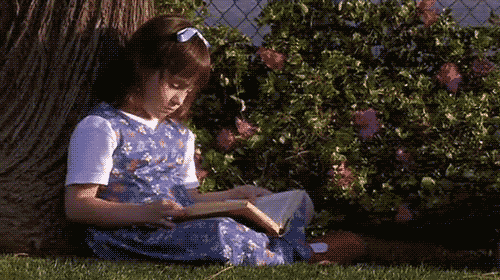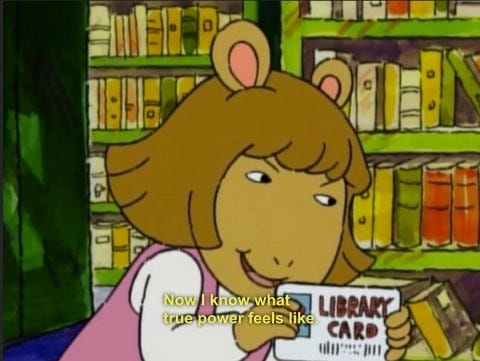David J. Bodenhamer uses the word place to examine the individual and collective experiences one has in a geographical space. Place goes beyond the coordinates of a space to delineate the feelings + people + ecology + memories of an area, along with the experience of being + interacting in that area.
Most of the narratives we construct focus not on space, an abstract geometrical concept, but rather on place, the particular expression of geographical space.1
I first learned about this concept in a Digital Humanities course last year, and the struggle about what makes a space a place is one that the library answers well.
At first glance, libraries are a simple place: it is one you go to a child that widens your imagination with each visit. It is a quiet space where you will learn about the world by reading words on pages. The silent façade of the library hides quite a radical history that when uncovered, holds many keys to challenging power structures. Armed with just a library card, you can access its collections of books, movies, and other materials. Information is free for all to use and discover in a library. While you’d have to pay about $30 for one book in a bookstore or pay $21 for a premium Netflix plan, the library offers your home more choices.
History of Libraries & Censorship
The library has an incredibly rich history in the spread of literacy and anti-fascism, among many others. Libraries have also been used to perpetuate these systems of oppression, but African-American libraries and literary societies in 19th century Jim Crow U.S. helped establish literary culture in Black communities. Libraries housed books, other printed texts, and materials, and more importantly, were social locations where reading led to conversation and printed texts of all varieties could be enjoyed, discussed, and debated in the company of others.
Libraries are - and have always been - inherently political. Its foundations are built upon the ideas of open and free access to information and community support. Libraries hold centuries of history and have rescued stolen books and documents. They centre the community and the public good and are a fundamental place in society. Knowledge is a way to learn about yourself and the world, and when used to challenge power structures, it can become a dangerous commodity to the elite.
Places are particular and inclusive; they are ‘organized worlds of meaning,’ characterized by experience, emotion, and memory. A place exists in past, present, and future time, whereas a space exists only in the present.2
The redistribution of power through the loaning of books (and other materials) directly challenges fascism.
Book burnings and segregation are two methods politicians in the past have used to destroy (access to) knowledge; their present counterparts can be found in book bans. Current challenges to books are based on what is “appropriate” for children, youth, or adults, a dangerous code for people of colour, LGBTQ+ themes, and anyone/thing whose existence “threatens” colonial, capitalist, hegemonic Western power.
John Chrastka states in an article about escalating book challenges that the problems are “either trying to dismantle the library, trying to put wedges between people, or to go after—this is the most concerning part of it—populations through the books that they’re targeting, rather than going after them directly.”
Despite challenges, public libraries continue to prominently display books that have been banned in the past and support open and free knowledge for everyone.
Why I Love Libraries
There are quite a few pieces of media that emphasize the library as a safe space and highlight the direct impact it has on people: Matilda, in particular, comes to mind. The most recent one I read is the novel What you are looking for is in the library by Michiko Aoyama, translated by Alison Watts. It is an incredibly sweet Japanese novel about five different characters who feel lost in life. They each find their way to their local library and meet a kind librarian who gives them books, including one that helps their problems and in turn, changes their lives.
If you’re active on social media, chances are you’ve come across Mychal Threets, a supervising librarian at Solano County Library, who has been all over my social media feeds this past year. He shares sweet stories about the joy of working at the library and seeing others gain the same joy from visiting the library with his 633k followers on Instagram (and similarly on other platforms). Mychal’s genuine and heartwarming videos fight back against mounting censorship by highlighting the countless services and offerings available at public libraries and reigniting the passion for all things library. In an interview with PRINT, he states that one of his favourite things about the public library is that it will “find something for every person who walks through the doors.”3
Libraries are so much more than books, movies, musical instruments, or even games. They provide a space where people can gather and create community. They support those who want or need to learn a new skill but can’t afford to pay hundreds or thousands of dollars to take a course. There is no prerequisite to spending time at the library and using its resources. Anyone and everyone is welcome and celebrated.
Threets: I’m like, ‘Yes. The library’s for you. You belong in this library. Keep on doing your thing.’ Basically, the library is a community hub. The library exists for the community.
Towards a Path of Action
(1) Support your local library
The easiest way to protect and support libraries is by using them! Libraries are completely free: if you’re also in Toronto, there are no card fees, late fees, or fees of any kind! I’m often quite busy with university work and can’t make it to the library in person that often, so I connected my library card to Overdrive or the Libby app to borrow ebooks or audiobooks. It’s a game changer for long vacations where you might not have space to bring physical books! You can watch movies or TV shows for free by borrowing DVDs or connecting your library card to digital streaming services like Hoopla or Kanopy. Isn’t that so much better than renting a movie or having subscriptions to 4 different streaming services (I’m calling myself out too)! You can visit the library and attend the various programs or events hosted there - it’s a great way to learn a new skill and make new friends! You can also encourage your friends and family to visit the library!
(2) Find alternative libraries
If you do some research, you can probably find an alternative library in your community that you can support. There are many examples of what it can look like, such as QPIRG-McGill Library, a community library and archive of radical materials in Tiohtià:ke (Montréal). They promote creative solutions to justice issues through skill-sharing activities, community-building projects, and educational resources.
There is also the Toronto Zine Library, which holds a public collection of zines, conducts workshops, and holds events that promote zines as a method of open communication and free expression.
If you live in the United States, the Queer Liberation Library launched recently. They are a digital library based in the U.S. that makes queer literature, information, and resources available for free to their library members. You can apply for a membership here.
Another great digital option is the Palestine Books Library, which has numerous free texts about Palestinian history, politics, and culture. It is curated by the Palestinian Youth Movement.
From QLL’s mission statement:
“As we build this library, we hope that it will be a way to bring our community closer together in a time when neoliberal capitalism seeks to isolate us and right-wing extremists seek to eliminate us. We will not be banned or removed.”
(3) Participate in LIBRARIES & LEMONADE
For The People is a political project aimed at building power on the Left to protect, defend, and expand public libraries in communities across the county. They seek to empower individuals and communities to take action to protect, expand, and defend their local public libraries. This action plan is more for the summer, but regardless, it is a brilliant way for you to defend public libraries by talking with your neighbours over a cup of lemonade! Their toolkit has a lemonade stand setup guide and tons of resources about why libraries are great and how we can help them. Learn more about it here.
(4) Listen to LibVoices (or other podcasts!)
LibVoices is an independent podcast that spotlights the experiences, achievements, and advice of racialized librarians. Its mission is to “learn more about the experience of librarians of colour and understand more about their place within the profession.” If you’re considering joining the profession (like me!), it’s a great place to hear stories from practicing librarians and archivists.
I hope you’ve come away from this post with a better understanding of why libraries are so important and cool! Thanks for reading!
P.S., I recently wrote an article for The Varsity about library etiquette and the lack of third places in Toronto. “Students go to the library for services, not silence,” was published in late January! You can check it out with the link above, or on page 8 in vol. 144, issue 16!
Bodenhamer, D.J. (2015). Narrating Space and Place. Deep Maps and Spatial Narratives, 14.
Bodenhamer, D.J. (2015). Narrating Space and Place. Deep Maps and Spatial Narratives, 14.








this is such a great idea, i love the way you synthesize your research!
I love our libraries in Toronto and love the idea of them being punk